Nof S.Y. Springer Handbook of Automation
Подождите немного. Документ загружается.

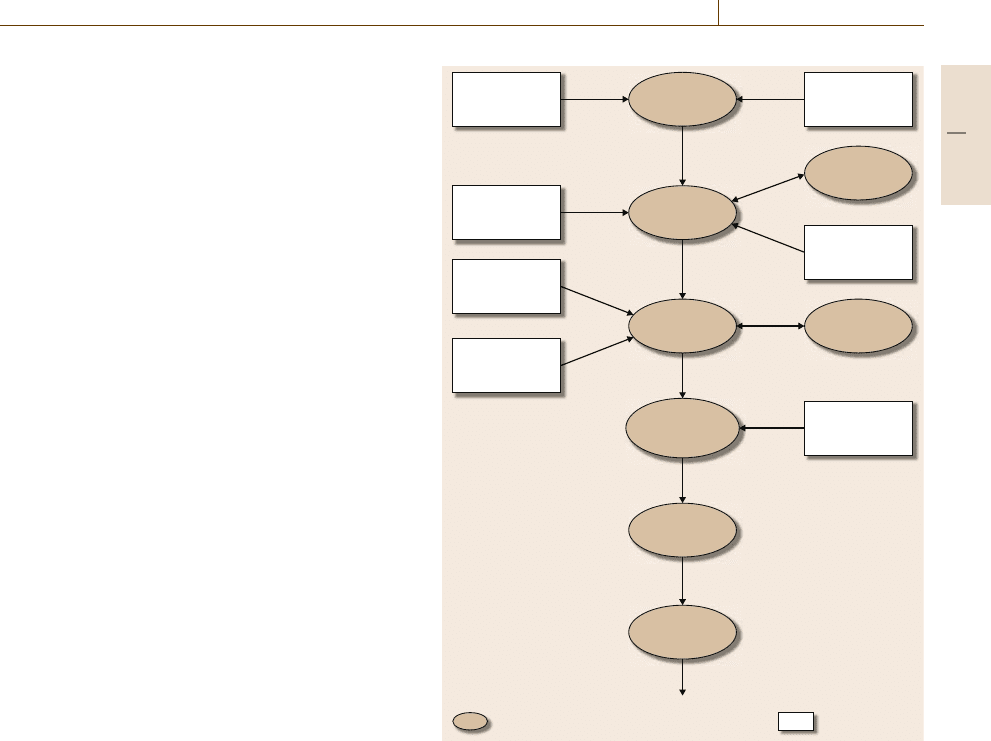
Process Automation 31.4 Control System Design 535
a detailed analysis or an explicit model is not required.
However, for complex processes, a process model is
invaluable both for control system design and for an
improved understanding of the process.
The major steps involved in designing and installing
a control system using the model-based approach are
shown in the flowchart of Fig. 31.3. The first step, for-
mulation of the control objectives, is a critical decision.
The formulation is based on the operating objectives for
the plants and the process constraints; for example, in
the distillation column control problem, the objective
might be to regulate a key component in the distil-
late stream, the bottoms stream, or key components in
both streams. An alternative would be to minimize en-
ergy consumption (e.g., heat input to the reboiler) while
meeting product quality specifications on one or both
product streams. The inequality constraints should in-
clude upper and lower limits on manipulated variables,
conditions that lead to flooding or weeping in the col-
umn, and product impurity levels.
After the control objectives have been formulated,
a dynamic model of the process is developed. The dy-
namic model can have a theoretical basis, for example,
physical and chemical principles such as conserva-
tion laws and rates of reactions, or the model can be
developed empirically from experimental data. If exper-
imental data are available, the dynamic model should be
validated, with the data and the model accuracy char-
acterized. This latter information is useful for control
system design and tuning.
The next step in the control system design is to de-
vise an appropriate control strategy that will meet the
control objectives while satisfying process constraints.
As indicated in Fig.31.3, this design activity is based on
models and plant data. Finally the control system can
be installed, with final adjustments performed once the
plant is operating.
31.4.1 Multivariable Control
In most industrial processes, there are a number of
variables that must be controlled, and a number of
variables can be manipulated. These problems are re-
ferred to as multiple-input multiple-output (MIMO)
control problems. For almost all important processes,
at least two variables must be controlled: product qual-
ity and throughput. Several examples of processes with
two controlled variables and two manipulated vari-
ables are shown in Fig.31.4. These examples illustrate
a characteristic feature of MIMO control problems,
namely, the presence of process interactions; that is,
Information from
existing plants
(if available)
Formulate
control
objectives
Management
objectives
Physical
and chemical
principles
Develop
process
model
Computer
simulation
Plant data
(if available)
Process control
theory
Experience with
existing plants
(if available)
Device control
strategy
Select control
hardware
and software
Install control
system
Adjust controller
settings
Final control
system
Computer
simulation
Vendor
information
Information baseEngineering activity
Fig. 31.3 Major steps in control system development [31.1]
each manipulated variable can affect both controlled
variables. Consider the inline blending system shown
in Fig. 31.4a. Two streams containing species A and B,
respectively, are to be blended to produce a produce
stream with mass flow rate w and composition x,the
mass fraction of A. Adjusting either manipulated flow
rate, w
A
or w
B
, affects both w and x.
Similarly, for the distillation column in Fig.31.4b,
adjusting either reflux flow rate R or steam flow S will
affect both distillate composition x
D
and bottoms com-
position x
B
. For the gas–liquid separator in Fig.31.4c,
adjusting the gas flow rate G will have a direct effect on
pressure P and a slower, indirect effect on liquid level h
because changing the pressure in the vessel will tend to
change the liquid flow rate L and thus affect h. In con-
trast, adjusting theother manipulatedvariable L directly
affects h but has only a relatively small and indirect
effect on P.
Part D 31.4
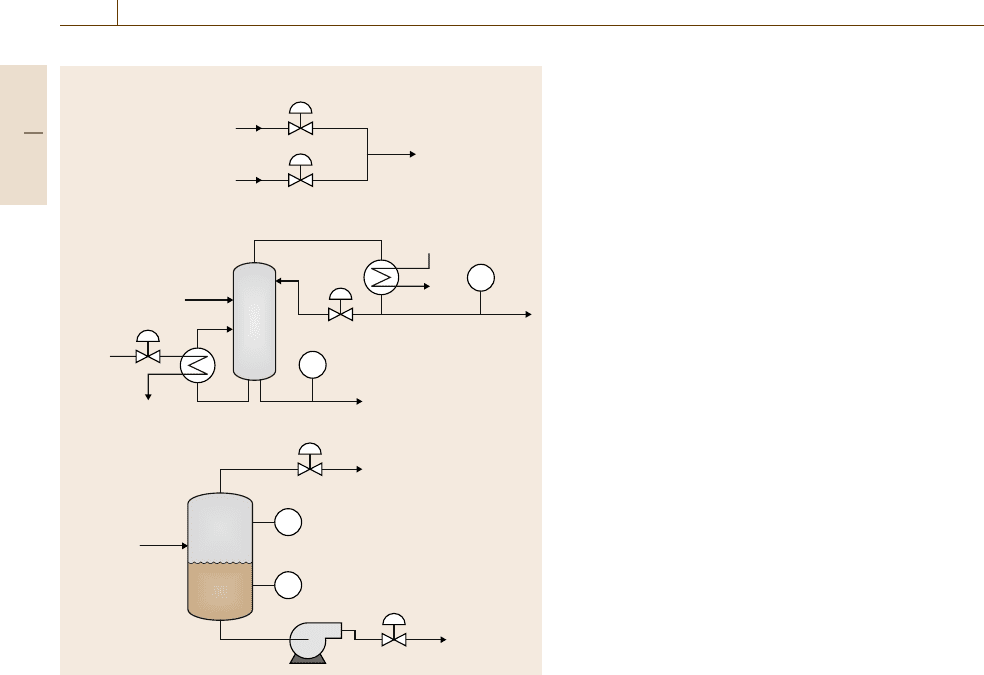
536 Part D Automation Design: Theory and Methods for Integration
a) Inline blending system
b) Destillation column
c) Gas–liquid separator
w
w
A
w
B
x
x
D
D
Gas
G
Liquid
L
x
B
B
P
h
R
Coolant
Steam
S
AT
AT
PT
LT
Feed
Feed
C
o
l
u
m
n
Fig. 31.4a–c Physical examples of multivariable control prob-
lems [31.1]
Pairing of a single controlled variable and a sin-
gle manipulated variable via a PID feedback controller
is possible, if the number of manipulated variables is
equal to the number of controlled variables. On the
other hand, more general multivariable control strate-
gies do not make such restrictions. MIMO control
problems are inherently more complexthan single-input
single-output (SISO) control problems because process
interactions occur between controlled and manipulated
variables. In general, a change in a manipulated vari-
able, say u
1
, will affect all of the controlled variables
y
1
, y
2
, ..., y
n
. Because of process interactions, selec-
tion of the best pairing of controlled and manipulated
variables for a multiloop control scheme can be a dif-
ficult task. In particular, for a control problem with n
controlled variables and n manipulated variables, there
are n! possible multiloop control configurations. Hence
there is a growing trend to use multivariable control,
in particular an approach called model predictive con-
trol (MPC).
Model predictive control offers several important
advantages: (1) the process model captures the dynamic
and static interactions between input, output, and dis-
turbance variables, (2) constraints on inputs and outputs
are considered in a systematic manner, (3) the con-
trol calculations can be coordinated with the calculation
of optimum set points, and (4) accurate model predic-
tions can provide early warnings of potential problems.
Clearly, the success of MPC (or any other model-
based approach) depends on the accuracy of the process
model. Inaccurate predictions can make matters worse,
instead of better.
First-generation MPC systems were developed in-
dependently in the 1970s by two pioneering industrial
research groups. Dynamic matrix control (DMC)was
devised by Shell Oil [31.3], and a related approach was
developed by ADERSA [31.4]. Model predictive con-
trol has had a major impact on industrial practice; for
example, an MPC survey by Qin and Badgwell [31.5]
reported that there were over 4500 applications world-
wide by the end of 1999, primarily in oil refineries and
petrochemical plants. In these industries, MPC has be-
come the method of choice for difficult multivariable
control problems that include inequality constraints.
The overall objectives of an MPC controller are as
follows:
1. Prevent violations of input and output constraints
2. Drive some output variables to their optimal set
points, while maintaining other outputs within spec-
ified ranges
3. Prevent excessive movement of the manipulated
variables
4. Control as many process variables as possible when
a sensor or actuator is not available.
A block diagram of a model predictive control sys-
tem is shown in Fig.31.5. A process model is used
to predict the current values of the output variables.
The residuals (the differences between the actual and
predicted outputs) serve as the feedback signal to a pre-
diction block. The predictions are used in two types of
MPC calculations that are performed at each sampling
instant: set-point calculations and control calculations.
Inequality constraints on the input and output variables,
such as upper and lower limits, can be included in either
type of calculation.
The model acts in parallel with the process and
the residual serves as a feedback signal, however, it
should be noted that the coordination of the control
and set-point calculation is a unique feature of MPC.
Part D 31.4
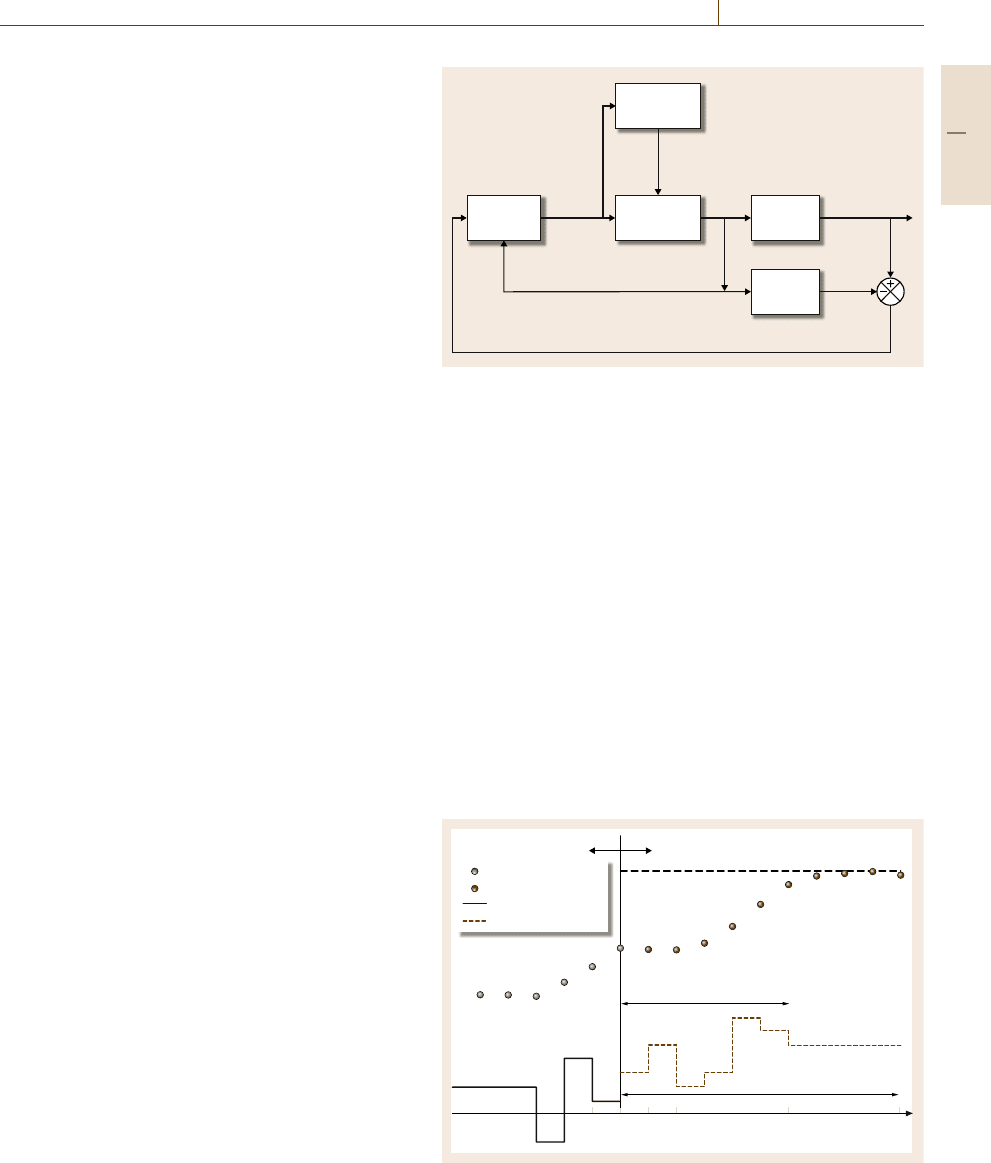
Process Automation 31.4 Control System Design 537
Furthermore, MPC has had a significant impact on
industrial practice because it is more suitable for con-
strained MIMO control problems.
The set points for the control calculations, also
called targets, are calculated from an economic opti-
mization based on a steady-state model of the pro-
cess, traditionally, a linear steady-state model. Typical
optimization objectives include maximizing a profit
function, minimizing a cost function, or maximizing
a production rate. The optimum values of set points
are changed frequently owing to varying process con-
ditions, especially changes in the inequality constraints.
The constraint changes are due to variations in process
conditions, equipment, and instrumentation, as well as
economic data such as prices and costs. In MPC the
set points are typically calculated each time the control
calculations are performed.
The control calculations are based on current mea-
surements and predictions of the future values of the
outputs. The predictions are made using a dynamic
model, typically a linear empirical model such as a mul-
tivariable version of the step response models that were
discussed in Sect.31.2. Alternatively, transfer func-
tion or state-space models can be employed. For very
nonlinear processes, it can be advantageous to pre-
dict future output values using a nonlinear dynamic
model. Both physical models and empirical models,
such as neural networks, have been used in nonlinear
MPC [31.5].
The objective of the MPC control calculations is
to determine a sequence of control moves (that is, ma-
nipulated input changes) so that the predicted response
moves to the set point in an optimal manner. The actual
output y, predicted output
ˆ
y, and manipulated input u
are shown in Fig.31.6. At the current sampling instant,
denoted by k,theMPC strategy calculates a set of M
values of the input {u{k+i −1), i =1, 2,...,M}. The
set consists of the current input u(k)andM −1 future
inputs. The input is held constant after the M control
moves. The inputs are calculated so that a set of P pre-
dicted outputs {
ˆ
y(k+i), i =1, 2,...,P} reaches the set
point in an optimal manner. The control calculations are
based on optimizing an objective function. The number
of predictions P is referred to as the prediction hori-
zon while the number of control moves M is called the
control horizon.
A distinguishing featureof MPCis itsreceding hori-
zon approach. Although a sequence of
M control moves
is calculated at each sampling instant, only the first
move is actually implemented. Then a new sequence
is calculated at the next sampling instant, after new
Set-point
calculations
Control
calculations
Prediction
Predicted
outputs
Inputs
Residuals
Set points
(targets)
Inputs
Process
outputs
Model
outputs
Process
Model
Fig. 31.5 Block diagram for model predictive control [31.1]
measurements becomeavailable; again, only the first in-
put move is implemented. This procedure is repeated at
each sampling instant.
In MPC applications, the calculated input moves
are usually implemented as set points for regulatory
control loops at the distributed control system (DCS)
level, such as flow control loops. If a DCS control loop
has been disabled or placed in manual mode, the input
variable is no longer available for control. In this situa-
tion, the control degrees of freedom are reduced by one.
Even though an input variable is unavailable for con-
trol, it can serve as a disturbance variable if it is still
measured.
Before each control execution, it is necessary to
determine which outputs (controlled variables (CV)),
inputs (manipulated variables (MV)), and disturbance
variables (DVs) are currently available for the MPC
Past output
Predicted future output
Past control action
Future control action
Past Future
Set point (target)
Control horizon, M
Prediction horizon, P
u
u
y
y
ˆ
k–1 kk+1 k+2 k+M–1
k+P
Sampling instant
Fig. 31.6 Basic concept for model predictive control
Part D 31.4
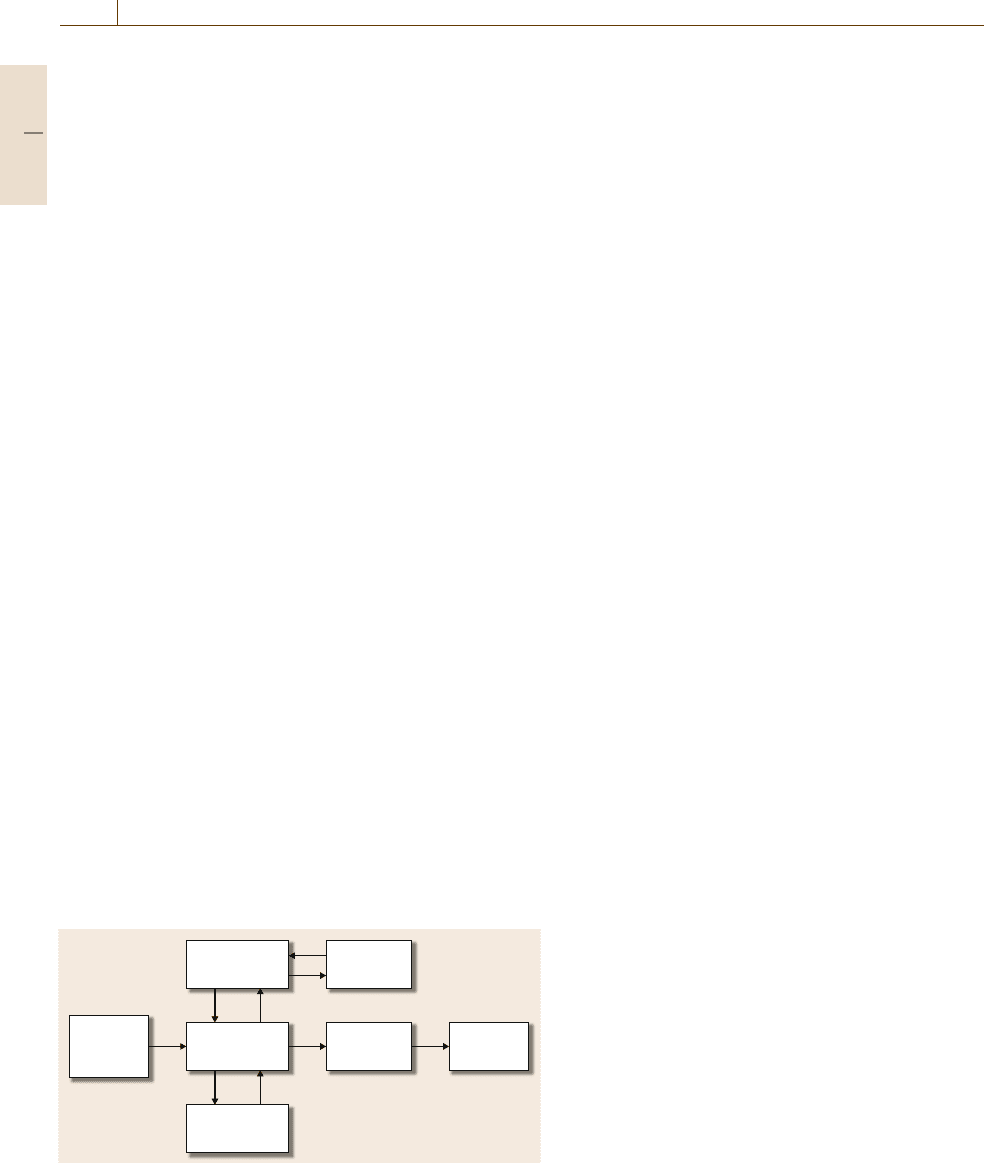
538 Part D Automation Design: Theory and Methods for Integration
calculations. The variables available for the control cal-
culations can change from one control execution time
to the next for a variety of reasons; for example, a sen-
sor may not be available owing to routine maintenance
or recalibration.
Inequality constraints on input and output variables
are important characteristics for MPC applications.
In fact, inequality constraints were a primary mo-
tivation for the early development of MPC. Input
constraints occur as a result of physical limitations on
plant equipment such as pumps, control valves, and
heat exchangers; for example, a manipulated flow rate
might have a lower limit of zero and an upper limit
determined by the pump, control valve, and piping
characteristics. The dynamicsassociated withlarge con-
trol valves impose rate-of-change limits on manipulated
flow rates.
Constraints onoutput variables are a key component
of the plant operating strategy; for example, a common
distillation column control objective is to maximize the
production rate while satisfying constraints on prod-
uct quality and avoiding undesirable operating regimes
such as flooding or weeping. It is convenient to make
a distinction between hard and soft constraints. As the
name implies, a hard constraint cannot be violated at
any time. By contrast, a soft constraint can be violated,
but the amount of violation is penalized by a modifi-
cation of the cost function. This approach allows small
constraint violations to be tolerated for short periods of
time [31.1].
31.5 Batch Process Automation
Batch processing is an alternative to continuous pro-
cessing. In batch processing, a sequence of one or more
steps, either in a single vessel or in multiple vessels,
is performed in a defined order, yielding a specific
quantity of a finished product. Because the volume of
product is normally small, large production runs are
achieved by repeating the process steps on a prede-
termined schedule. In batch processing, the production
amounts are usually smaller than for continuous pro-
cessing; hence, it is usually not economically feasible
to dedicate processing equipment to the manufacture
of a single product. Instead, batch processing units are
organized so that a rangeof products(from a few to pos-
sibly hundreds) can be manufactured with a given set
of process equipment. Batch processing can be compli-
cated byhavingmultiple stages, multiple products made
from the same equipment, or parallel processing lines.
The key challenge for batch plants is to consistently
manufacture each product in accordance with its speci-
Run-to-run
control
Sequential
control
Logic
control
Control
during the
batch
Production
management
Equipment
control
Safety
interlocks
Fig. 31.7 Overview of a batch control system
fications while maximizing the utilization of available
equipment. Benefits include reduced inventories and
shortened response times to make a specialty product
compared with continuous processing plants. Typically,
it is not possible to use blending of multiple batches in
order to obtain the desired product quality, so product
quality specifications must be satisfied by each batch.
Batch processingis widelyused to manufacture spe-
cialty chemicals, metals, electronic materials, ceramics,
polymers, food and agricultural materials, biochemicals
and pharmaceuticals, multiphasematerials/blends, coat-
ings, and composites – an extremely broad range of
processes and products. The unit operations in batch
processing are also quite diverse, and some are analo-
gous to operations for continuous processing.
In analogy with the different levels of plant control
depicted in Fig.31.1, batch control systems operate at
various levels:
•
Batch sequencing and logic controls (levels 1 and 2)
•
Control during the batch (level 3)
•
Run-to-run control (levels 4 and 5)
•
Batch production management (level 5).
Figure 31.7 shows the interconnections of the differ-
ent types of control used in a typical batch process.
Run-to-run control is a type of supervisory control
that resides principally in the production management
block. In contrast to continuous processing, the focus of
control shifts from regulation to set-point changes, and
sequencing of batches and equipment takes on a much
greater role.
Part D 31.5

Process Automation 31.5 Batch Process Automation 539
Batch control systems must be very versatile to be
able to handle pulse inputs and discrete input/output
(I/O) as well as analog signals for sensors and actuators.
Functional control activities are summarized as follows:
1. Batch sequencing and logic control: Sequencing of
control steps that follow a recipe involves, for ex-
ample, mixing of ingredients, heating, waiting for
a reaction to complete, cooling, and discharging the
resulting products.Transferof materials to and from
batch tanks or reactors includes metering of mater-
ials as they are charged (as specified by the recipe),
as well as transfer of materials at the completion of
the process operation. In addition to discrete logic
for the control steps, logic is needed for safety in-
terlocks to protect personnel, equipment, and the
environment from unsafe conditions. Process inter-
locks ensure that process operations can only occur
in the correct time sequence.
2. Control during the batch: Feedback control of
flow rate, temperature, pressure, composition, and
level, including advanced control strategies, falls
in this category, which is also called within-the-
batch control [31.6]. In sophisticated applications,
this requires specification of an operating trajectory
for the batch (that is, temperature or flow rate as
a function of time). In simpler cases, it involves
tracking of set points of the controlled variables,
which includes ramping the controlled variables up
and down and/or holding them constant for a pre-
scribed period of time. Detection of when the batch
operations should be terminated (end point) may be
performed by inferential measurements of product
quality, if direct measurement is not feasible.
3. Run-to-run control: Also called batch-to-batch con-
trol, this supervisory function is based on offline
product quality measurements at the end of a run.
Operating conditions and profiles for the batch are
adjusted between runs to improve the product qual-
ity using tools such as optimization.
4. Batch production management: This activity entails
advising the plant operator of process status and
how to interact with the recipes and the sequential,
regulatory, and discretecontrols. Complete informa-
tion (recipes) is maintained for manufacturing each
product grade, including the names and amounts of
ingredients, process variable set points, ramp rates,
processing times, and sampling procedures. Other
database information includes batches produced on
a shift, daily, or weekly basis, as well as material
and energy balances. Scheduling of process units
is based on availability of raw materials and equip-
ment and customer demand.
Recipe modifications from one run to the next are com-
mon in many batch processes. Typical examples are
modifying the reaction time, feed stoichiometry, or re-
actor temperature. When such modifications are done
at the beginning of a run (rather than during a run),
the control strategy is called run-to-run control. Run-to-
run control is frequently motivated by the lack of online
measurements of the product quality during a batch run.
In batch chemical production, online measurements are
often not available during the run, but the product can
be analyzed by laboratory samples at the end of the run.
The processengineer mustspecify a recipe that contains
the values of the inputs (which may be time-varying)
that will meet the product requirements. The task of the
run-to-run controller is to adjust the recipe after each
run to reduce variability in the output product from the
stated specifications.
Batch run-to-run control is particularly useful to
compensate for processes where the controlled vari-
able drifts over time; for example, in a chemical
vapor deposition process the reactor walls may become
fouled owing to byproduct deposition. This slow drift
in the reactor chamber condition requires occasional
changes to the batch recipe in order to ensure that the
controlled variables remain on target. Eventually, the
reactor chamber must be cleaned to remove the wall
deposits, effectively causing a step disturbance to the
process outputs when the inputs are held constant. Just
as the run-to-run controller compensates for the drift-
ing process, it can also return the process to target after
a step disturbance change [31.7,8].
The Instrument Society of America (ISP) SP-88
standard deals with the terminology involved in batch
control [31.9]. There are a hierarchy of activities that
take place in a batch processing system [31.10]. At the
highest level, procedures identify how the products are
made, that is, the actions to be performed (and their or-
der) as well as the associated control requirements for
these actions. Operations are equivalent to unit opera-
tions in continuous processing and include such steps as
charging, reacting, separating, and discharging. Within
each operation are logical points called phases, where
processing can be interrupted by operator or computer
interaction. Examples of different phases include the
sequential addition of ingredients, heating a batch to
a prescribed temperature, mixing, and so on. Control
steps involvedirect commands tofinal control elements,
specified by individual control instructions in software.
Part D 31.5

540 Part D Automation Design: Theory and Methods for Integration
As an example, for {operation = charge reactant} and
{phase =add ingredient B}, the control steps would be:
(1) open the B supply valve, (2) total the flow of B over
a period of time until the prescribed amount has been
added, and (3) close the B supply valve.
The term recipe has a range of definitions in batch
processing, but in general a recipe is a procedure with
the set of data, operations, and control steps required to
manufacture a particular grade of product. A formula
is the list of recipe parameters, which includes the raw
materials, processing parameters, and product outputs.
A recipe procedure has operations for both normal and
abnormal conditions. Each operation contains resource
requests forcertain ingredients (and their amounts). The
operations in the recipe can adjust set points and turn
equipment on and off. The complete production run for
a specific recipeis calleda campaign(multiple batches).
In multigrade batch processing, the instructions re-
main the same from batch to batch, but the formula can
be changedto yieldmodest variations in the product;for
example, in emulsion polymerization, different grades
of polymers are manufactured by changing the formula.
In flexible batch processing, both the formula (recipe
parameters) and the processing instructions can change
from batch to batch. The recipe for each product must
specify both the raw materials required and how condi-
tions within the reactor are to be sequenced in order to
make the desired product.
Many batch plants, especially those used to man-
ufacture pharmaceuticals, are certified by the Interna-
tional Standards Organization (ISO). ISO 9000 (and
the related ISO standards 9001–9004) state that every
manufactured product should havean established,docu-
mented procedure, and the manufacturer should be able
to document that the procedure was followed. Compa-
nies must pass periodic audits to main ISO 9000 status.
Both ISO 9000 and the US Food and Drug Admin-
istration (FDA) require that only a certified recipe be
used. Thus, if the operation of a batch becomes ab-
normal, performing any unusual corrective action to
bring it back within the normal limits is not an option.
In addition, if a slight change in the recipe apparently
produces superior batches, the improvement cannot be
implemented unless the entire recipe is recertified. The
FDA typically requires product and raw materials track-
ing, so that product abnormalities can be traced back to
their sources.
Recently, in an effort to increase the safety, effi-
ciency, and affordability of medicines, the FDA has
proposed a new framework for the regulation of phar-
maceutical development, manufacturing, and quality
assurance. The primary focus of the initiative is to
reduce variability through a betterunderstanding ofpro-
cesses than can be obtained by the traditional approach.
Process analytical technology (PAT) has become an
acronym in the pharmaceutical industry for design-
ing, analyzing, and controlling manufacturing through
timely measurements (i. e., during processing) of crit-
ical quality and performance attributes of raw and
in-process materials and processes, with the goal of
ensuring final product quality. Process variations that
could possibly contribute to patient risk are determined
through modeling and timely measurements of critical
quality attributes, which are then addressed by pro-
cess control. In this manner processes can be developed
and controlled in such a way that quality of product is
guaranteed.
Semiconductor manufacturing is an example of
a large-volume batch process [31.7]. In semiconductor
manufacturing an integrated circuit consists of several
layers of carefully patterned thin films, each chemically
altered to achieve desired electrical characteristics.
These devices are manufactured through a series of
physical and/or chemical batch unit operations simi-
lar to the way in which speciality chemicals are made.
From 30 to 300 process steps are typically required to
construct a set of circuits on a single-crystalline sub-
strate called a wafer. The wafers are 4 to 4–12inch
(100–300 mm) in diameter, 400–700μm thick, and
serve as the substrate upon which microelectronic cir-
cuits (devices) are built. Circuits are constructed by
depositing the thin films (0.01–10μm) of material of
carefully controlled composition in specific patterns
and then etching these films to exacting geometries
(0.35–10μm).
The main unit operations in semiconductor man-
ufacturing are crystal growth, oxidation, deposition
(dielectrics, silicon, metals), physical vapor deposition,
dopant diffusion, dopant-ion implantation, photolithog-
raphy, etch, and chemical–mechanical polishing. Most
processes in semiconductor manufacturing are semi-
batch; for example, in a single-waferprocessing tool the
following steps are carried out:
1. A robotic arm loads the boat of wafers
2. The machine transfers a single wafer into the pro-
cessing chamber
3. Gases flow continuously and reaction occurs
4. The machine removes the wafer
5. The next wafer is processed.
When all wafers are finished processing, the operator
takes the boat of wafers to the next machine. All of
Part D 31.5

Process Automation 31.6 Automation and Process Safety 541
these steps are carried out in a clean room designed to
minimize device damage by particulate matter.
For a given tool or unit operationa specified number
of wafers are processed together in a lot, which is car-
ried in a boat. There is usually an extra slot in the boat
for a pilot wafer, which is used for metrology reasons.
A cluster tool refers to equipment which has several
single-wafer processing chambers. The chambers may
carry out the same process or different processes; some
vendors base their chamber designs on series operation,
while others utilize parallel processing schemes.
The recipe for the batch consists of the regulatory
set points and parameters for the real-time controllers
on the equipment. The equipment controllers are nor-
mally not capable of receiving a continuous set-point
trajectory. Only furnaces and rapid thermal processing
tools are able to ramp up, hold, and ramp down their
temperature or power supply. A recipe can consist of
several steps; each step processes a different film based
on specific chemistry. The same recipe on the same type
of chamber may produce different results, due to differ-
ent processes used in the chamber previously. This lack
of repeatability across chambers is a big problem with
cluster tools or when a fabrication plant (fab) has multi-
ple machines of the same type, because it requires that
a fab keep track of different recipes for each chamber.
The controller translates the desired specs into a ma-
chine recipe. Thus, the fab supervisory controller only
keeps track of the product specifications.
Factory automation in semiconductor manufactur-
ing integrates the individual equipment into higher
levels of automation, in order to reduce the total cy-
cle time, increase fab productivity, and increase product
yield [31.8]. The major functions provided by the au-
tomation system include:
1. Planning of factory operation from order entry
through wafer production
2. Scheduling of factory resources to meet the produc-
tion plan
3. Modeling and simulation of factory operation
4. Generation and maintenance of process and product
specification and recipes
5. Tracking of work-in-progress (WIP)
6. Monitoring of factory performance
7. Machine monitoring, control, and diagnosis
8. Process monitoring, control, and diagnosis.
Automation of semiconductor manufacturing in the
future will consist of meeting a range of technological
challenges. These include the needfor fasteryield ramp,
increasing cost pressures that compel productivity im-
provements, environmental safety and health concerns,
and shrinking device dimensions and chip size. The de-
velopment of 300 mm platforms in the last few years
has spawned equipment with new software systems and
capabilities. These systems will allow smart data col-
lection, storage, and processing on the equipment, and
transfer of data and information in a more efficient
manner. Smart data management implies that data are
collected as needed and based upon events and metrol-
ogy results. As a result of immediate and automatic
processing of data, a larger fraction of data can be ana-
lyzed, and more decisions aredata driven.Newsoftware
platforms provide the biggest opportunity for a control
paradigm shift seen in the industry since the introduc-
tion of statistical process control.
31.6 Automation and Process Safety
In modern chemical plants, process safety relies on the
principle of multiple protection layers. A typical config-
uration is shown in Fig.31.8. Each layer of protection
consists of a grouping of equipment and/or human ac-
tions. The protection layers are shown in the order of
activation that occurs as a plant incident develops. In the
inner layer, the process design itself provides the first
level of protection. The next two layers consist of the
basic process control system (BPCS) augmented with
two levels of alarms and operator supervision or in-
tervention. An alarm indicates that a measurement has
exceeded its specified limits and may require operator
action.
The fourth layer consists of a safety interlock
system (SIS), which is also referred to as a safety
instrumented system or as an emergency shutdown
(ESD) system. The SIS automatically takes corrective
action when the process and BPCS layers are unable
to handle an emergency; for example, the SIS could
automatically turn off the reactant pumps after a high-
temperature alarm occurs for a chemical reactor. Relief
devices such as rupture discs and relief valves pro-
vide physical protection by venting a gas or vapor if
overpressurization occurs. As a last resort, dikes are
located around process units and storage tanks to con-
tain liquid spills. Emergency response plans are used
Part D 31.6
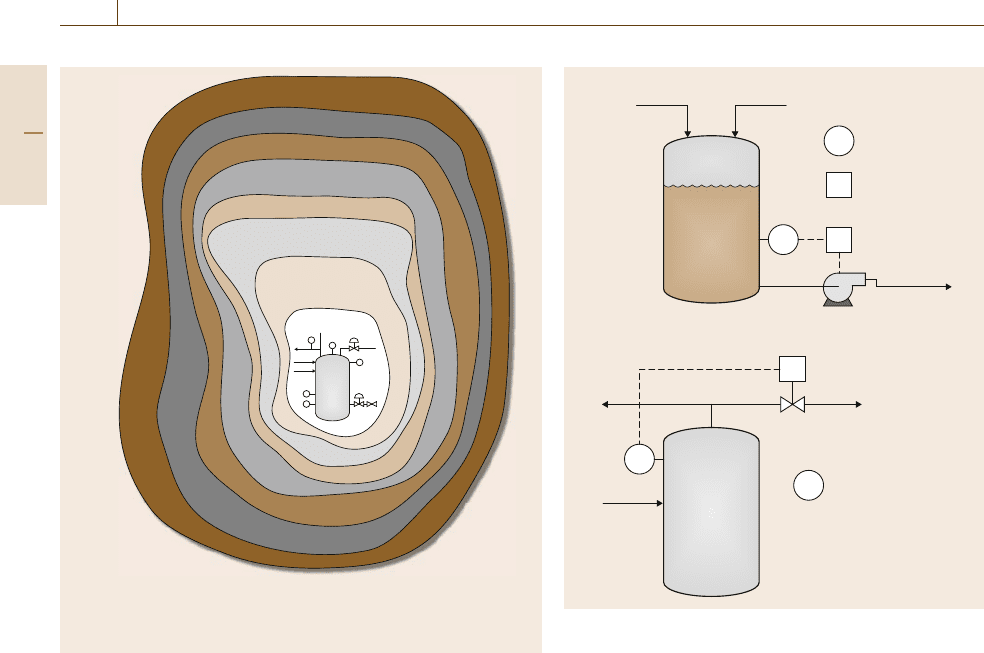
542 Part D Automation Design: Theory and Methods for Integration
Community emergency response
Community emergency response
Plant emergency response
Plant emergency response
Physical protection (dikes)
Physical protection (dikes)
Physical protection
(relief devices)
Automatic action SIS or ESD
Critical alarms, operator
supervision, and manual intervention
Basic controls
process alarms, and
operator supervision
Process design
Note:
Protection layers for a typical process are shown in the order of activation
expected as a hazardous condition is approached
ESD = Emergency shutdown; SIS = Safety interlock system
Fig. 31.8 Typical layers of protection in a modern chemical
plant [31.11]
to address emergency situations and to inform the
community.
The functioningof the multiple layer protection sys-
tem can be summarized as follows [31.11]:
Most failures in well-designed and operated chem-
ical processes are contained by the first one or two
protection layers. The middle levels guard against
major releases and the outermost layers provide
mitigation response to very unlikely major events.
For major hazard potential, even more layers may
be necessary.
It is evident from Fig.31.8 that automation plays an
important role in ensuring process safety. In particu-
lar, many of the protection layers in Fig. 31.8 involve
instrumentation and control equipment. The SIS oper-
ation is designed to provide automatic responses after
alarms indicate potentially hazardous situations. The
objective is to have the process reach a safe condition.
The automatic responses are implementedvia interlocks
and automatic shutdown and start-up systems. Distinc-
a) Low-level interlock
b) High-pressure interlock
Liquid
storage
tank
Gas
out
To
flare stack
Gas
in
Gas
storage
tank
LSL
PSH
PSH
LSL = Level switch low
= Pressure switch high
S
S
S
= Solenoid switch
Fig. 31.9a,b Two interlock configurations [31.1]
tions are sometimes made between safety interlocks and
process interlocks; process interlocks are used for less
critical situations to provide protection against minor
equipment damage and undesirable process conditions
such as the production of off-specification product.
Twosimple interlock systemsare shown in Fig.31.9.
For the liquid storage system, the liquid level must stay
above a minimum value in order to avoid pump damage
such as cavitation. If the level drops below the specified
limit, the low-level switch (LSL) triggers both an alarm
and a solenoid (S), which acts as a relay and turns the
pump off. For the gas storage system in Fig. 31.9b, the
solenoid-operated valve is normally closed. However,
if the pressure of the hydrocarbon gas in the storage
tank exceeds a specified limit, the high-pressure switch
(PSH) activates an alarm and causes the valve to open
fully, thus reducing the pressure in the tank. For inter-
lock and other safety systems, a switch can be replaced
by a transmitter if the measurement is required. Also,
transmitters tend to be more reliable.
The SIS in Fig.31.9 serves as an emergency backup
system for the BPCS. TheSIS automaticallystarts when
a critical process variable exceeds specified alarm limits
that define the allowable operating region. Its initiation
Part D 31.6
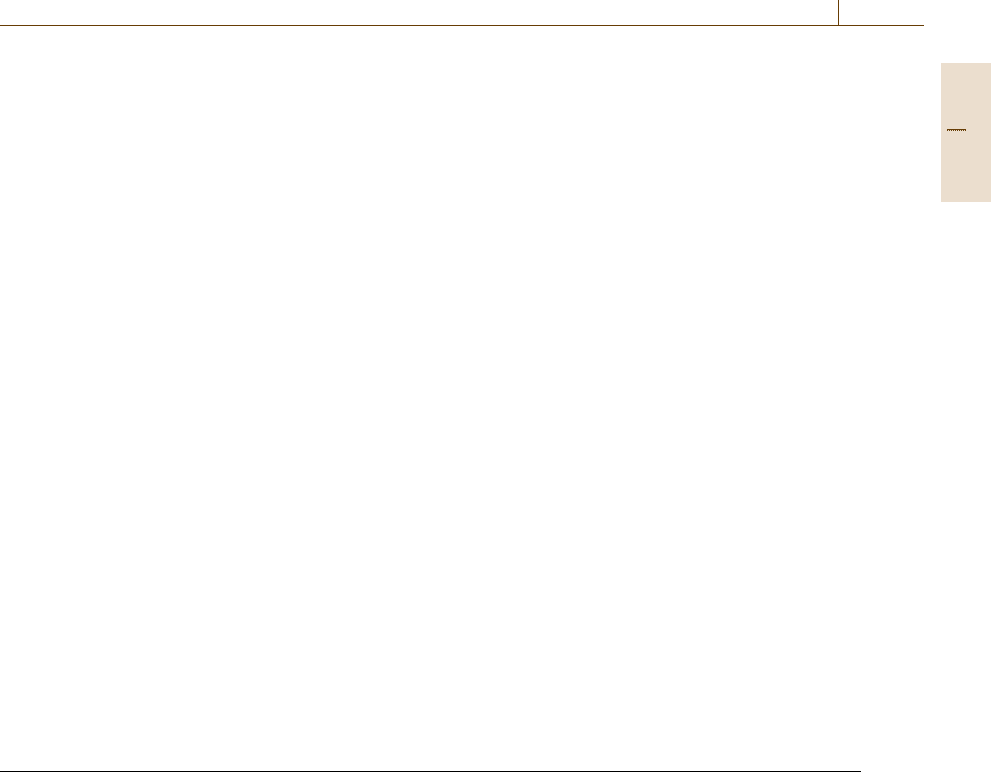
Process Automation References 543
results in a drastic action such as starting or stopping
a pump or shutting down a process unit. Consequently,
it is used only as a last resort to prevent injury to people
or equipment.
It is very important that the SIS function indepen-
dently of the BPCS; otherwise emergency protection
will be unavailable during periods when the BPCS
is not operating (e.g., due to a malfunction or power
failure). Thus, the SIS should be physically sepa-
rated from the BPCS and have its own sensors and
actuators. Sometimes redundant sensors and actua-
tors are utilized; for example, triply redundant sensors
are used for critical measurements, with SIS actions
based on the median of the three measurements. This
strategy prevents a single sensor failure from crip-
pling SIS operation. The SIS also has a separate
set of alarms so that the operator can be notified
when the SIS initiates an action (e.g., turning on an
emergency cooling pump), even if the BPCS is not
operational.
31.7 Emerging Trends
Main emerging trends in process automation have to do
with process integration, information integration, and
engineering integration. The theme across all of these
is the need for a greater degree of integration of all
components of the process. A thorough discussion on
the implications of these trends and their challenges on
process automation can be found in this Handbook in
Chap.8.
31.8 Further Reading
•
A. Cichocki, H.A. Ansari, M. Rusinkiewicz,
D. Woelk: Workflow and Process Automation: Con-
cepts and Technology, 1st edn. (Springer, London
1997)
•
P. Cleveland: Process automation systems Control
Eng. 55(2), 65–74 (2008)
•
S.-L. Jämsä-Jounela: Future trends in process au-
tomation Annu. Rev. Control, 31(2), 211–220
(2007)
•
J. Love: Process Automation Handbook: A Guide
to Theory and Practice, 1st edn. (Springer, London
2007)
References
31.1 D.E. Seborg, T.F. Edgar, D.A. Mellichamp: Process
Dynamics and Control, 2nd edn. (Wiley, New York
2004)
31.2 T.F. Edgar, C.L. Smith, F.G. Shinskey, G.W. Gass-
man, P.J. Schafbuch, T.J. McAvoy, D.E. Se-
borg: Process control. In: Perry’s Chemical
Engineering Handbook, ed. by R.H. Perry,
D.W. Green, J.O. Maloney (McGraw-Hill, New York
2008)
31.3 C.R. Cutler, B.L. Ramaker: Dynamic matrix con-
trol – a computer control algorithm, Proc. Jt.
Auto. Control Conf., paper WP5-B (San Francisco
1980)
31.4 J. Richalet, A. Rault, J.L. Testud, J. Papon:
Model predictive heuristic control: applications
to industrial processes, Automatica 14,413–428
(1978)
31.5 S.J. Qin, T.A. Badgwell: A survey of industrial model
predictive control technology, Control Eng. Pract.
11, 733–764 (2003)
31.6 D. Bonvin: Optimal operation of batch reactors –
a personal view, J. Process Control 8, 355–368
(1998)
31.7 T.G. Fisher: Batch Control Systems: Design, Appli-
cation, and Implementation (ISA, Research Triangle
Park 1990)
31.8 J. Parshall, L. Lamb: Applying S88: Batch Control
from a User’s Perspective (ISA, Research Triangle
Park 2000)
31.9 T.F. Edgar, S.W. Butler, W.J. Campbell, C. Pfeif-
fer, C. Bode, S.B. Hwang, K.S. Balakrishnan,
J. Hahn: Automatic control in microelectronics
manufacturing: practices, challenges and possibil-
ities, Automatica 36, 1567–1603 (2000)
31.10 J. Moyne, E. del Castillo, A.M. Hurwitz (Eds.): Run to
Run Control in Semiconductor Manufacturing (CRC,
Boca Raton 2001)
31.11 AIChE Center for Chemical Process Safety: Guidelines
for Safe Automation of Chemical Processes (AIChE,
New York 1993)
Part D 31
“This page left intentionally blank.”
